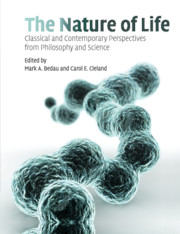Book contents
- Frontmatter
- Contents
- Preface
- Acknowledgments
- Sources
- About the authors
- Introduction
- SECTION I CLASSICAL DISCUSSIONS OF LIFE
- 1 De Anima (selections)
- 2 Treatise on Man
- 3 Critique of the teleological power of judgment (selections)
- 4 What is Life? (selections)
- 5 The nature of life
- 6 What is the meaning of “life”?
- 7 The principles of life (selections)
- SECTION II THE ORIGIN AND EXTENT OF NATURAL LIFE
- SECTION III ARTIFICIAL LIFE AND SYNTHETIC BIOLOGY
- SECTION IV DEFINING AND EXPLAINING LIFE
- Supplementary bibliography on life
- Index
4 - What is Life? (selections)
Published online by Cambridge University Press: 10 November 2010
- Frontmatter
- Contents
- Preface
- Acknowledgments
- Sources
- About the authors
- Introduction
- SECTION I CLASSICAL DISCUSSIONS OF LIFE
- 1 De Anima (selections)
- 2 Treatise on Man
- 3 Critique of the teleological power of judgment (selections)
- 4 What is Life? (selections)
- 5 The nature of life
- 6 What is the meaning of “life”?
- 7 The principles of life (selections)
- SECTION II THE ORIGIN AND EXTENT OF NATURAL LIFE
- SECTION III ARTIFICIAL LIFE AND SYNTHETIC BIOLOGY
- SECTION IV DEFINING AND EXPLAINING LIFE
- Supplementary bibliography on life
- Index
Summary
THE GENERAL CHARACTER AND THE PURPOSE OF THE INVESTIGATION
This little book arose from a course of public lectures, delivered by a theoretical physicist to an audience of about 400 which did not substantially dwindle, though warned at the outset that the subject-matter was a difficult one and that the lectures could not be termed popular, even though the physicist's most dreaded weapon, mathematical deduction, would hardly be utilized. The reason for this was not that the subject was simple enough to be explained without mathematics, but rather that it was much too involved to be fully accessible to mathematics. Another feature which at least induced a semblance of popularity was the lecturer's intention to make clear the fundamental idea, which hovers between biology and physics, to both the physicist and the biologist.
For actually, in spite of the variety of topics involved, the whole enterprise is intended to convey one idea only—one small comment on a large and important question. In order not to lose our way, it may be useful to outline the plan very briefly in advance.
The large and important and very much discussed question is:
How can the events in space and time which take place within the spatial boundary of a living organism be accounted for by physics and chemistry?
The preliminary answer which this little book will endeavor to expound and establish can be summarized as follows:
The obvious inability of present-day physics and chemistry to account for such events is no reason at all for doubting that they can be accounted for by those sciences.
- Type
- Chapter
- Information
- The Nature of LifeClassical and Contemporary Perspectives from Philosophy and Science, pp. 50 - 69Publisher: Cambridge University PressPrint publication year: 2010
- 3
- Cited by

